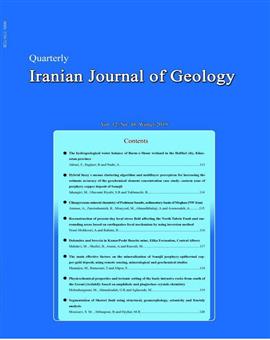بازسازی میدان تنش محلی امروزی مؤثر بر گسل شمال تبریز و مناطق پیرامون آن براساس سازوکاز کانونی زلزله¬ها با استفاده از روش وارون
الموضوعات :احد نوری مخوری 1 , بهنام رحیمی 2
1 - دانشگاه فردوسی
2 - دانشگاه فردوسی
الکلمات المفتاحية: جدایش تنش گسل شمال تبریز مکانیسم کانونی زلزله میدان تنش. ,
ملخص المقالة :
در این مطالعه، میدان تنش زمین ساختی امروزی مؤثر بر گسل شمال تبریز و نواحی پیرامون آن با استفاده از 37 سازوکار کانونی زلزله های جمع آوری شده از منابع مختلف، بازسازی شده است. برای تعیین ماهیت سازوکار کانونی زلزله ها و دامنه تغییرات ماهیت آن ها در رژیم های مختلف زمین ساختی از نمودارهای مثلثی استفاده شده است. ماهیت سازوکار این داده ها از رژیم امتدادلغزی تا راندگی تغییر می کند. برای به دست آوردن تنسورهای تنش تقلیل یافته ای که بیشترین تعداد داده ها در آن شرکت کنند و میدان های بازسازی شده، پوشش کاملی نسبت به تنش های مؤثر بر منطقه داشته باشد، فرایند جدایش تنش ها برروی داده ها برای جداسازی رژیم های زمین ساختی متفاوت از سیستم چند مرحله ای اعمال شد. نتایج تحلیل وارون و جدایش داخلی داده ها، نشان می دهد در این منطقه سه سامانه تنش عمل می کنند. بهطور جالب توجهی هر سه سامانه تنش دارای جهت فشارش افقی در جهت شمال غرب-جنوب شرق تا شمال شمال غرب-جنوب جنوب شرق هستند. جهت بیشینه فشارش در هر کدام از رژیم های تنش اول، دوم و سوم به ترتیب 329/09، 310/28 و 138/03 می باشد.
زمانی قره چمنی، ب.، 1392. مدل زمینساخت فلات آذربايجان (شمال گسل تبريز و جنوب ارس)، فصلنامه علوم زمین، 87، 50-41.
سیاهکالی مرادی، ع.، تاتار، م.، هاتسفلد، د. و آن، پ.، 1387. مطالعه ساختار سرعتی پوسته و ساز و کار گسلش در زون گسلی امتدادلغز تبریز، فصلنامه علوم زمین، 70، 153-140.
نوری مخوری، ا.، 1392. مطالعه ساختار و سایزموتکتونیک گسل شمال تبریز (فاصله بستان¬آباد تا مرند) و برآورد تنش¬های تکتونیکی مرتبه سوم. پایاننامه کارشناسی ارشد، دانشگاه تبریز، 126 .
نوری مخوری، ا.، زمانی قره چمنی ب.، موید م. و فریدی م.،1392.تحلیل تنش امروزی در امتداد گسل شمال تبریز بر اساس داده¬های سازوکار کانونی زلزله¬ها. سی و دومین گردهمایی و نخستین کنگره بین¬المللی تخصصی علوم زمین.
Azizi, H. and Moinevaziri, M., 2009. Review of the tectonic setting of Cretaceous to Quaternary volcanism in northwestern Iran. Journal of Geodynamics, 47, 167–179.
Bada, G., Horváth, F., Dövényi, P., Szafián, P., Windhoffer, G. and Cloetingh, S., 2007. Present-day stress field and tectonic inversion in the Pannonian basin. Global and Planetary Change, 58, 165–180.
Berberian, M. and Arshadi, S., 1976. On the evidence of the youngest activity of the North Tabriz Fault and the seismicity of Tabriz city. Geolgy Survey of Iran, Repport 39, 397–418.
Berberian, M. and Yeats, R.S., 1999. Patterns of historical earthquake rupture in theIranian Plateau. Bulletin of the Seismological Society of America, 89, 120–139.
Berberian, M., 1977. Contribution to the seismotectonics of Iran . Ministry of Industry and Mines, Geological and Mining Survey of Iran, Tectonic and Seismotectonic Research Section, 3.
Bott, M.H.P., 1959. The mechanisms of oblique slip faulting. Geological Magazine, 96, 109-117.
Copley, A. and Jackson, J., 2006. Active tectonics of the Turkish‐Iranian plateau. Tectonics, 25,6, 1-19.
De Vicente, G.D., Cloetingh, S.A.P.L., Muñoz-Martín, A., Olaiz, A., Stich, D., Vegas, R., Galindo‐Zaldívar, J. and Fernández‐Lozano, J., 2008. Inversion of moment tensor focal mechanisms for active stresses around the microcontinent Iberia: Tectonic implications. Tectonics, 27,1, 1-22.
Delvaux, D. and Barth, A., 2010. African stress pattern from formal inversion of focal mechanism data. Tectonophysics, 482, 105–128.
Delvaux, D. and Sperner, B., 2003. New aspects of tectonic stress inversion with reference to the TENSOR program. Geological Society, London, Special Publications, 212, 75-100.
Frohlich, C., 1992. Triangle diagrams: Ternary graphs to display similarity and diversity of earthquake focal mechanisms, Physics of the Earth and Planetary Interiors, 75, 193–198.
Hessami, K., Pantosti, D., Tabassi, H., Shabanian, E., Abbassi,M.R., Feghhi, K. and Solaymani, S., 2003. Paleoearthquakes and slip rates of the North Tabriz Fault, NWIran: preliminary results. Annals of Geophysics, 46, 903–915.
Jackson,J. and McKnenzie,D., 1984. Activetectonics of the Alpine- Himalayan Belt between western Tutkey and Pakistan.Geophysical Jouranal International, 77,1,185-246.
Lee, C.F., Hou, J.J. and Ye, H.,1997. The movement potential of the major faults in Hong Kong area. Episodes, 20, 227-231.
Mesbahi, F., Mohajjel, M. and Faridi, M., 2016. Neogene oblique convergence and strain partitioning along the North Tabriz Fault, NW Iran. Journal of Asian Earth Sciences, 129, 191-205.
Siahkali Moradi, A., Hatzfeld, D. and Tatar, M., 2011. Microseismicity and seismotectonics of the North Tabriz fault, Iran. Tectonophysics, 506, 22–30
.Solaymani Azad, S., Dominguez, S., Philip, H., Hessami, K., Forutan, MR., Shahpasan Zadeh, M. and Ritz, J.F., 2011. The Zandjan fault system: Morphological and tectonic evidences of a new active fault network in the NW of Iran. Tectonophysics, 506, 73–85.
Soleymani Azad, S., Philip, H., Dominguez, S., Hessami, K., Shahpasandzadeh, M., Foroutan, M., Tabassi, H. and Lamothe, M., 2015. Paleoseismological and morphological evidence of slip rate variations along the North Tabriz fault (NW Iran). Tectonophysics, 640, 20-38.
Soumaya, A., Ayed, NB., Delvaux, D. and Ghanmi, M., 2015. Spatial variation of present-day stress field and tectonic regime in Tunisia and surroundings from formal inversion of focal mechanisms: Geodynamic implications for central Mediterranean. Tectonics, 34, 1154–1180.
Vernant, P., Nilforoushan, F., Hatzfeld, D., Abassi, M.R., Vigny, C., Masson, F., Nankali, H., Martinod, J., Ashtiani, M., Bayer, R., Tavakoli, F. and Chery, J., 2004. Present-day crustal deformation and plate kinematics in the Middle East constrained by GPS measurements in Iran and northern Oman. Geophysical Journal International, 157, 381–398.
Wallace, R.E., 1951. Geometry of shearing stress and relation to faulting. Journal of Structural Geology, 59, 118–130.
Zoback, M. L., 1992. First and second order patterns of stress in the lithosphere: The World Stress Map project. Journal of Geophysical Research, Solid Earth, 97(B8), 11703–11728.


